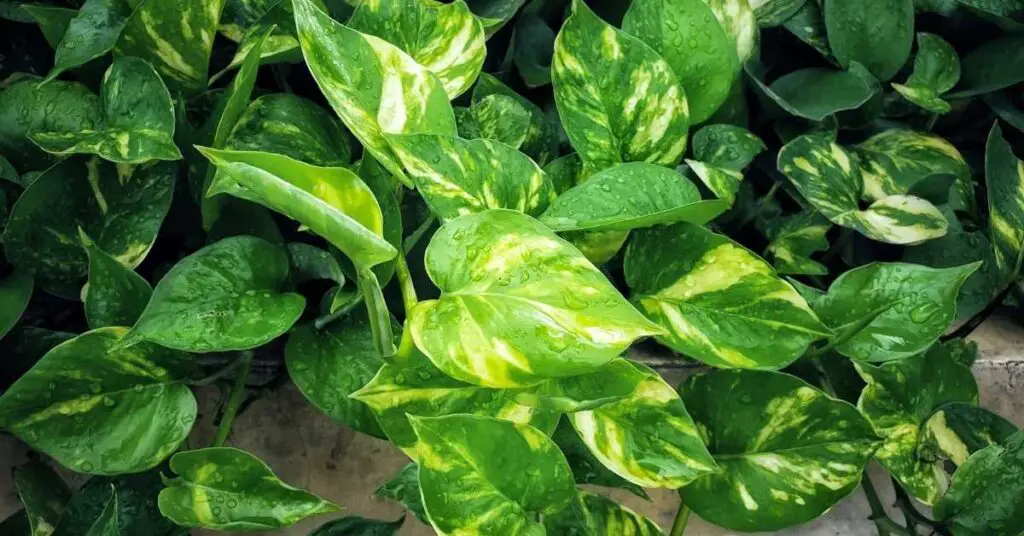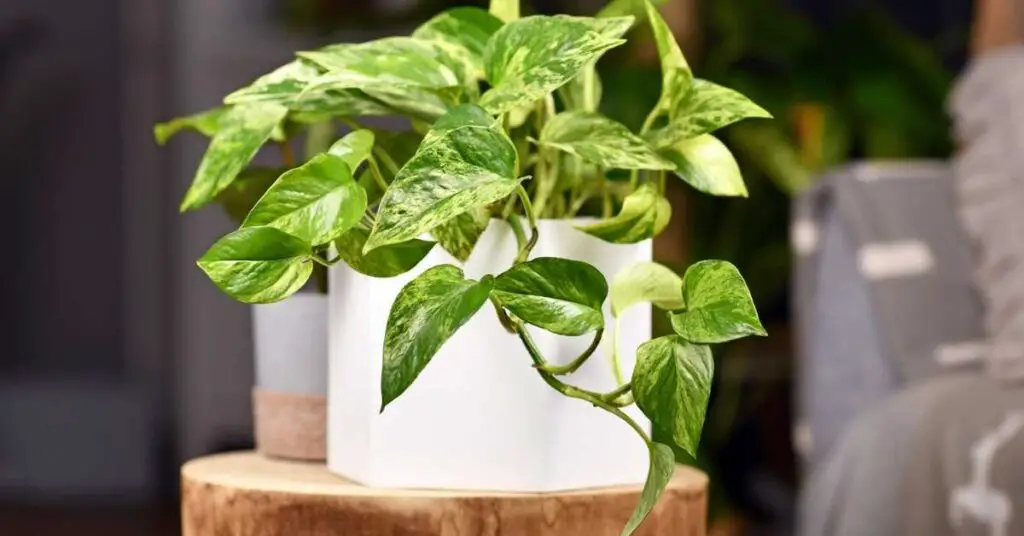We’re an Affiliate. As an affiliate, we earn from qualifying purchases. We get commissions for purchases made through links in this post.
What to do with aerial roots on Pothos? You really do not have to do anything with the aerial roots that are growing from the stem of your pothos as these roots are natural. The pothos plant produces and uses these aerial roots when they start to spread along the ground, climb up a trellis or structure, and they help take up moisture and nutrients from the soil to help the plant grow.
If you have a pothos plant, you may have noticed aerial roots growing out of it. While these roots may look strange, they serve an important purpose.
There are several different plants that form these aerial roots along the stem or near the base of the plant and as the plant grows these roots make contact with the ground to help keep the plant standing up strong, they take up nutrients and more.
In this blog post, you will learn what to do with aerial roots on pothos and how to care for your plant.
What are Aerial Roots?
Most plants have roots that grow downward, anchoring the plant in the ground and absorbing water and nutrients from the soil. However, some plants, such as pothos, have aerial roots that grow upward.
These roots are typically thinner and less hairy than traditional roots, and they often have a light green or white color. Aerial roots serve a variety of functions, depending on the plant species.
In some cases, they help the plant to climb surfaces or attach itself to support. In other cases, they may help to absorb moisture from the air or to store water for the plant during dry periods.
Regardless of their function, aerial roots are an integral part of many plant species and play a vital role in the health of the plant.
What are the functions of aerial roots?
Aerial roots fulfill the same function as ordinary roots: they provide support.
a) To stabilize a plant, however, rather than stabilizing the plant in the soil like soil roots do, aerial roots assist a plant in anchoring itself to trees or other structures and assisting it in climbing. In nature, many vining plants use aerial roots to climb trees to reach higher levels of the canopy where there is more sunlight. A monstera plant, for example, is an example of this.
b) Secondly, it serves to aid in the absorption of moisture and dissolved nutrients from rainwater that runs down the roots and branches of trees.

What to do with aerial roots on Pothos?
It is unnecessary to discard the aerial roots you have removed from your Pothos. They have the potential to be advantageous in the process of reproduction.
Make a few stem cuttings, ensuring that each one has at least one node, aerial roots, and three to four top leaves.
With each snip of the stems, sterilize the cutting tool to prevent the transmission of infections between plants.
If you allow the stems of your Pothos to flow over the edge of a wall, container, or other plants, aerial roots are likely to develop.
Aerial roots are plant roots that emerge above the surface of the ground. They almost invariably occur as a result of chance.
In a variety of plant species, including orchids (Orchidaceae), tropical coastal swamp trees such as mangroves, banyan figs (Ficus subg. Urostigma), the warm-temperate rainforest rata (Metrosideros robusta), and the pohutukawa trees of New Zealand, they can be found in abundance (M. excelsa).
Aerial roots are also seen in vines such as common ivy (Hedera helix) and poison ivy (Toxicodendron radicans).
What does it mean to have aerial roots?
In particular, any root exposed to the air, such as one of the roots found in epiphytes and climbers that is not in contact with the soil but is normally responsible for anchoring the plant to its support and is frequently involved in photosynthesis — see also prop root.
What causes Pothos to develop aerial roots?
Pothos is a type of vine that is known for its ability to grow quickly and vigorously.
One distinctive feature of pothos is that they often develop aerial roots or roots that grow out from the stem of the plant and into the air.
There are a few different reasons why pothos may develop aerial roots. One reason is that the plant is growing bigger and trying to climb or attach itself to something nearby.
Another reason is that the plant is seeking out additional support because it is growing too large for its current structure.
Additionally, pothos may develop aerial roots in response to changes in temperature or humidity. Whatever the reason, aerial roots are a fascinating feature of pothos plants!
Is it possible to trim the roots of Pothos?
Propagating a piece is possible as long as each component contains a node.
In addition, it is a good idea to cut from a relatively new piece of the plant because that area is already growing and healthy, and it has a good chance of producing new, healthy roots very rapidly.
Are aerial roots beneficial?
Yes, aerial roots are beneficial for the plant. Aerial roots are responsible for a variety of functions.
They aid in the exchange of air, the spread of seeds, the stability of the plant, and the provision of nutrients.
Aerial roots can often be removed without causing harm to the plant in most circumstances. In some instances, though, they are critical to the plant’s health and should be left alone.
Can you plant pothos aerial roots?
Pothos, often known as Devil’s Ivy, is one of the most straightforward houseplants to grow.
You have to take a clip from the vine and immerse it in some water. These aerial roots will begin to grow as soon as the roots are submerged in water.
Is it necessary to bury aerial roots?
The aerial roots should not be submerged even if the orchid needs to be repotted. Because these roots are not accustomed to being buried, burying them beneath the potting material may cause them to rot.
The air roots, responsible for absorbing moisture from the air, are typically not irrigated.
Is it necessary to cut the aerial roots of Pothos?
Those who identify as such can cut themselves off. You will not cause any harm to the plant. In the same way that cutting earth roots does not hurt your plant (in fact, it encourages root growth), aerial pruning roots does not affect your plant in any manner at all.
If you want to get rid of them completely, cut as near the main stem as possible.
Frequently Asked Questions (FAQs) about aerial roots on Pothos
Below are some frequently asked questions about Pothos aerial roots:
What is causing my Pothos to turn yellow?
The majority of the time, yellowing is caused by over or underwatering. If you notice a combination of yellow and brown on the same leaf, it is most often the result of overwatering the plant.
If you notice yellow leaves on some of your plants and some crispy brown areas on other plants, you may be experiencing underwatering.
Verify whether or not the soil matches your diagnosis by checking in with it again.
How do I tell if my Pothos has root rot?
Overwatering circumstances can result in root rot, which occurs when roots die back owing to a lack of oxygen in the soil.
Root rot can be caused by pathogens (fungus) that live in the soil and becomes overgrown due to excessive watering.
Pothos root rot can be identified by the fact that its leaves will slowly begin to wilt and yellow even while the soil is moist or that the roots will feel soggy and appear brown or black when you check the roots.
If you believe that your plant suffers from root rot, DO NOT overwater it.
Allow the soil in your container to dry out before watering again.
What should I do if my Pothos has root rot?
Although it may seem harsh, removing the plant from the environment is the most effective way to deal with root rot. If you desire to maintain it, you must decrease soil moisture!
Don’t offer more water than is necessary to meet the plants’ requirements without producing stressful drought conditions or overwatering.
How can I train my Pothos to climb a stake?
To climb the stake or trellis, gently wrap and thread the plant around it, using twine to link the vines as needed (but be careful not to knot the plant too tightly).
Continue to care for the plant in the same manner as before, but spray the plant’s foliage occasionally.
A higher level of relative humidity in the air encourages the growth of roots throughout the vine’s length, which will eventually anchor the plant to a post or trellis.
Eventually, the plant will grow upwards on its own, and you will be able to remove the string if you so choose.
In Conclusion
So, if you’re looking for an interesting and easy-to-care-for plant to liven up your home or office, pothos is a great option. And if you’re lucky enough to have one that starts growing aerial roots, don’t be alarmed – it’s just the plant doing what comes naturally!




